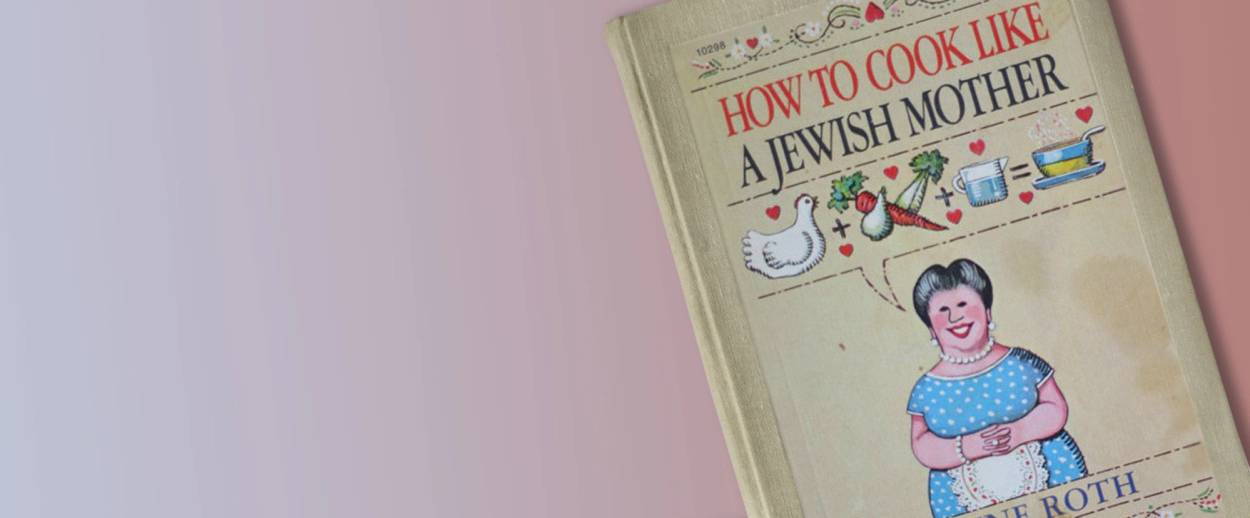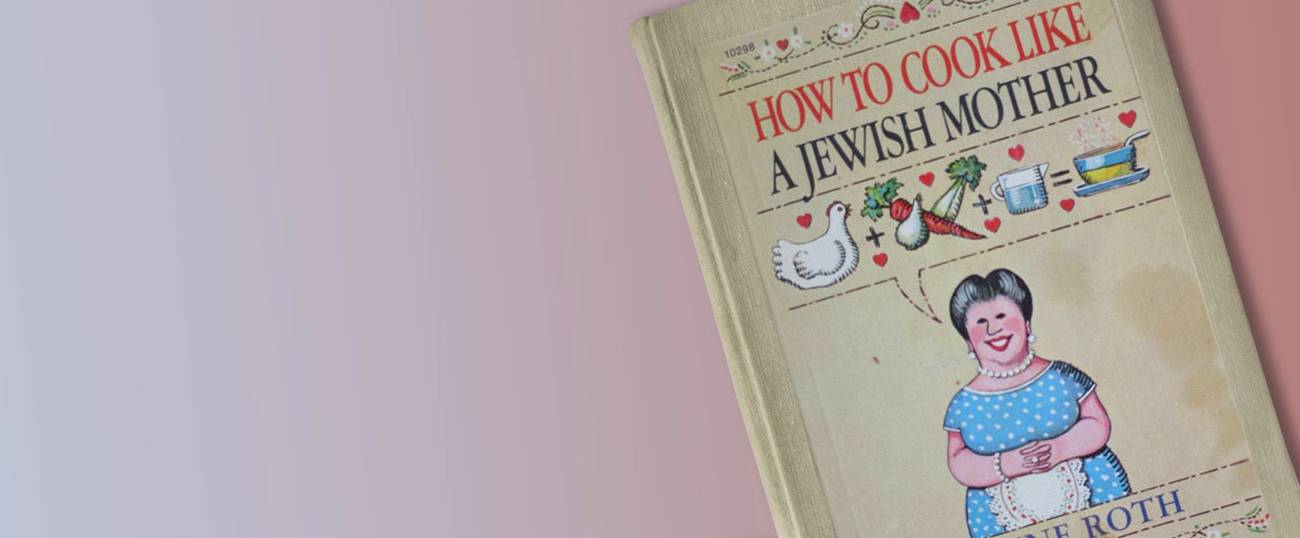Getting Back to Basics in the Kitchen
As an experiment, I gave up Googling recipes and relied instead on an old cookbook from my mother’s shelf, ‘How to Cook Like a Jewish Mother.’ The results were delicious.




My grandmother used to cook by relying on her intuition, and a little bit of luck. “I learned by watching my mother,” Grandma would tell us. “I didn’t learn how to prepare meals from a book.”
Unfortunately, she wasn’t much of a cook.
So when it came time for my mother to start cooking, she didn’t learn by watching her mother. Instead, my grandmother gave her a little hardcover bible of a book called How to Cook Like a Jewish Mother. Written in 1969 by June Roth, published by Simon & Schuster, the book contains not only recipes but sweet and witty commentary throughout. Beginning with a quote from the Book of Proverbs—“She looketh well to the ways of her household, And eateth not the bread of idleness”—the reader is taken on an almost breathless journey through the basic tenets of cooking like a Jewish mother.
The first chapter, “How to Tell a Jewish Mother,” declares: “Scratch a Jewish mother and you’ll find a tiger underneath! She forages the best food for her family, and prepares it with traditional skills.” And later on in the book, the chapter called “You’ve Got to Have Tam” tells us: “One simple factor distinguishes the balabusta from the aspiring Jewish cook, and that is: Tam. Tam literally means good taste, but with reference to Jewish cooking, it means the right taste.”
Other chapter headings include “Jewish Penicillin and Other Magic Brews,” “Meaty With Memories,” “Ess From the Cookie Jar,” and “A Balabusta’s Bake Off.” The book concludes with the classic question, “A Little Fruit, Maybe?” It’s an irresistible little volume of wisdom, with no pictures. The only image is on the book’s cover, which offers up a drawing of a round-looking woman, plump in the face (the kind of woman you’d trust to teach you how to make a good matzo ball or kugel). She’s wearing lipstick, and she has pearls around her neck (just like Grandma).
The book quickly became my mother’s old faithful, remaining in her kitchen for decades—well-thumbed, coffee-stained, scribbled on and over, pages falling out. She cooked from the book often when I was growing up. To this day, her homemade beef goulash, meatloaf, and banana bread are tastes I call upon if I’m feeling stressed out; these are my go-to comfort foods. I realize now that all those recipes came from this one cookbook. She also made a split-pea soup, which I didn’t like when I was a child (too healthy, no doubt), but now I love it. It seems that my taste buds have evolved in perfect tandem with my Jewish-mother inclinations.
When I was about to start college, I began to learn how to cook—and like my mother, I relied on cookbooks, in my case $10 paperbacks with concise, extraordinarily dull titles such as Cooking for One and The College Student’s Guide to Cooking. As I left my college years behind, the cookbooks I acquired were prettier, more chic, heavier. Hardbacks with beautiful photographs replaced tatty old paperbacks. How to be a Domestic Goddess and Jerusalem got a lot of use as I learned the skills necessary to host dinners and lunches.
But few of those bulky cookbooks stayed in my possession for very long. I moved to new cities, countries, apartments. I got married, I got divorced. Cookbooks gathering dust on the bookshelf were always among the first items to be given away to Goodwill when packing for yet another move. Over 15 years, I moved 12 times, and only a handful of my beloved cookbooks stayed with me. A cookbook my Great Aunt Ida had given me when I was 25, called New York Cookbook, I kept for sentimental reasons; it reminded me of my time living in New York and made me feel connected with Ida, especially after she passed away at age 94. I found The Sentinel Jewish Cookbook, a little hardcover book from the 1930s, in a thrift shop in upstate New York; I fell in love with the quirky charm of it without ever actually putting it to use. It sat on my bookshelf for years, adding character to my otherwise modern collection of books.
When I was first learning to cook, the internet was new, used mainly for email; Google was not yet a cook’s resource. But by my late 30s, Google had become my constant companion in the kitchen—recipes I found online fast became my staple dishes. All my questions were answered in an instant: How do I convert this measurement to that one? How do I make the creamiest mashed potatoes? How do I get my brisket just tender enough? With such resources at my fingertips, even my most favored cookbook—Ida’s—gathered dust on my shelf.
And then something happened. I started to feel increasingly uncomfortable with spending so much time on my phone or laptop—in life, but especially in the kitchen. I enjoy cooking, and the notion of the kitchen being a peaceful, cathartic place, a place where I can get into the flow of making something from scratch after a long day at work. Consulting a device for a recipe or the answer to a question disturbed that flow, and with it, the calm: Checking for the next step in a recipe came with the annoyance of message alerts that distracted me from the task at hand.
A few months ago, over at my mother’s house for Sunday lunch, she made the delicious Hungarian goulash of my childhood, and when I asked if I could have the recipe, she handed me that old gem of hers, How to Cook Like a Jewish Mother. It was then that I decided to try a little experiment: I’d use only old cookbooks to cook, forsaking all electronic devices in the kitchen. And so it was that last December I tried my hand at some of that book’s recipes: brisket pot roast, carrot tzimmes, scallion-dressed mashed potato, and, as the finale, seeing as I had bought a bag of carrots anyway, carrot pudding.
I realized that I’d missed the familiar process of running my finger down an index to find what I’m looking for. Clicking through sites online turned out to be far less satisfying than thumbing through an old cookbook—even when, or, more accurately, especially when, the pages were stuck together with something unidentified. Sometimes I didn’t find what I was looking for in that trusty index, and I surprised myself: Instead of defaulting to the internet, I’d choose to make something else I’d found in the book.
I wrote down the ingredients for each recipe on real paper; I wasn’t going to bring my phone into this experiment. I was intrigued by the simplicity of ingredients in the old recipes; sugar, salt, pepper, honey, and lemons were some of the most common ingredients. Herbs were almost nonexistent in these recipes, and making meat without any felt like a foreign concept to me, but I gave it a shot. I rubbed my brisket with salt and caressed peppercorns into its side. I renounced rosemary or mint in favor of yet more salt and pepper. In addition, in the name of being authentic to the experiment at hand, I let go of my healthy-eating resolutions.
This little book was, I realize now, helping me to learn how to cook Jewish food, just as it had helped my mother before me. If I’d craved the comfort food from my childhood before, I’d always bought it, ready-made from a deli or the supermarket; I’d rarely taken it upon myself to cook it from scratch—until now.
Going old-school was good for my budget: It was cheaper to shop for these basic ingredients than the healthy, organic ones I usually try to consume. Sugar is cheaper than modern-day substitutes like coconut oil or Splenda, white flour more cost-effective than buckwheat flour. Sometimes I was tempted to adapt a recipe, to use freshly peeled and bagged baby carrots instead of real carrots—but then I remembered that my grandma didn’t have the option to buy bagged baby carrots. I wanted to peel my own carrots: If Grandma did it that way, it was good enough for me. Walking in the shoes of the matriarchs who had come before me somehow linked me to them.
Most of the old recipes are short by today’s standards, just one or two paragraphs. The sentences are often startling in their conciseness, and sometimes I had to take a minute to try to figure out exactly what was meant by a phrase as simple as, say: “Brown the meat quickly in the hot oil,” or “Have ready the carrot and onion.” I used common sense and figured things out.
The blogs I follow online have photographs that document each stage of the cooking process, whereas these books held simply black words on white pages. It was a mystery what my food would look like when it was done, and I liked that. Also, there was no comparing of how my food looked with the image that had been styled and Instagrammed to perfection online, which felt refreshing.
My favorite dish from the book is a Passover recipe called Blitz Kuchen: a sweet almond cake with plenty of sugar and lemon. I’ve found that it turns out moist and soft every time. As Roth writes in the book: “No bakery can include the ingredient of affection that a Jewish mother adds to her batter. Although her efforts will be quickly devoured, the crumbs of loving memory will remain.”
Unfortunately, I didn’t have as much luck with the beef goulash. Each time I tried it, my beef cubes came out too chewy and didn’t have the tenderness of my mother’s beef. What’s a Jewish girl to do? This: I’ve invited my mother over. I’m going to have her show me first-hand how to make that goulash taste just right.
I bought a few more vintage Jewish cookbooks while I was conducting the experiment. Consulting my older Jewish relatives, I found The New Complete Jewish International Cookbook and The Book of Jewish Food. The food that these classic recipes inspired in my modern kitchen made me a little wistful for my childhood, for my grandmother’s conversation with me at the dinner table. My taste buds learned to love latkes, kugels, tortes, and goulash from a very young age—that’s a gift that continues to give, and one I enjoy sharing with those in my life today.
As enjoyable as it was to make these old recipes, I will admit that I missed my herbs. I also put on a pound or two during this experiment, perhaps not surprising, considering all the white flour and sugar. Regardless, I’m going to continue to use these books as my mentors as I pursue my path to cooking like a Jewish mother, but in the spirit of adaptation, I’m going to give myself permission to do just as my grandma did—to “add a bit of this, a bit of that,” to “break away from the rules and try your own twist.” I’m going to make the recipes a little healthier, but remain true to Grandma, Mom, and Jewish tradition. Not long ago, I discovered a fantastic book by Leah Koenig called Modern Jewish Cooking, a book in which traditional recipes have been given modern, healthier makeovers. I’ve added it to my collection, and it sits happily next to How to Cook Like a Jewish Mother.
***
Like this article? Sign up for our Daily Digest to get Tablet Magazine’s new content in your inbox each morning.
Amy Schreibman Walter is a writer and teacher living in London. Follow her @amyswalter